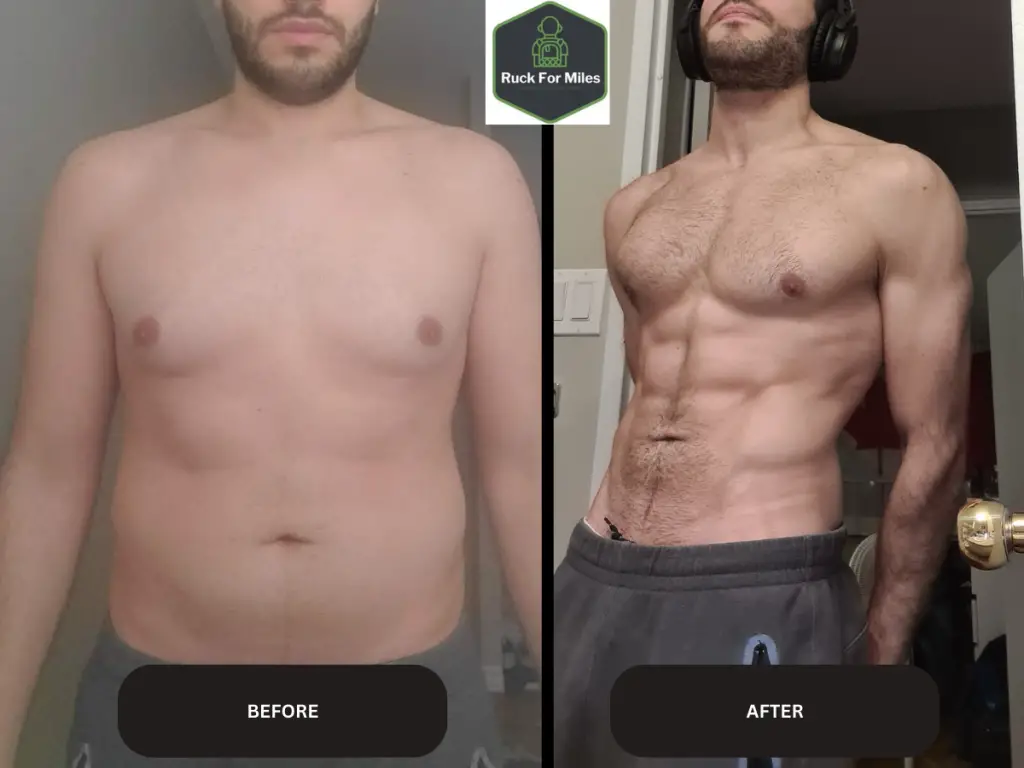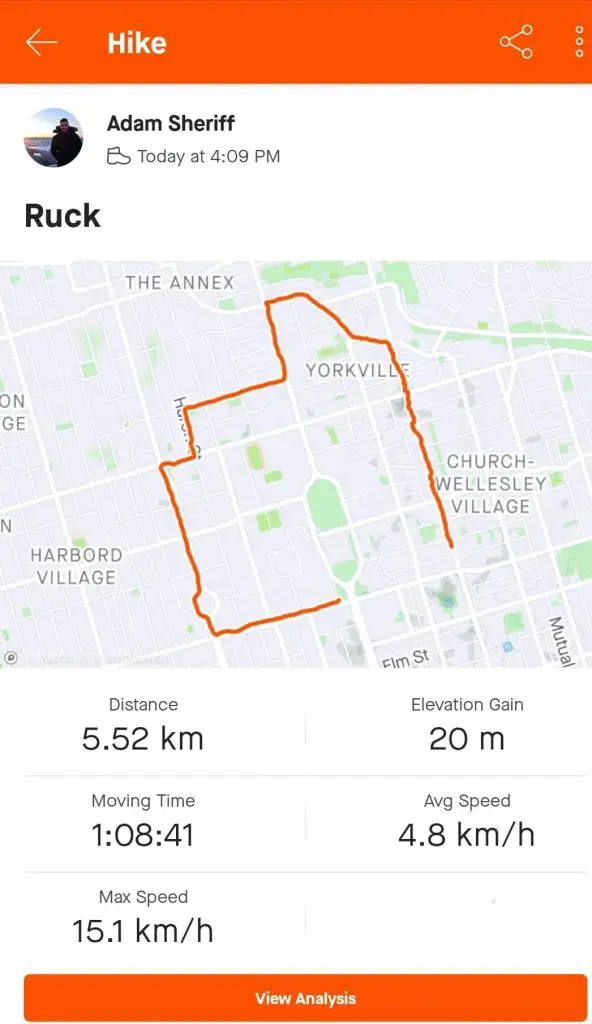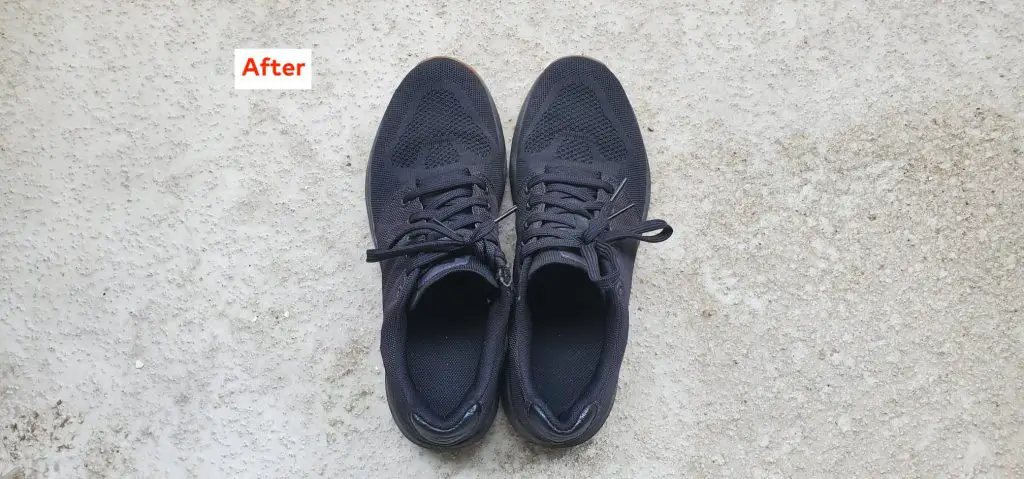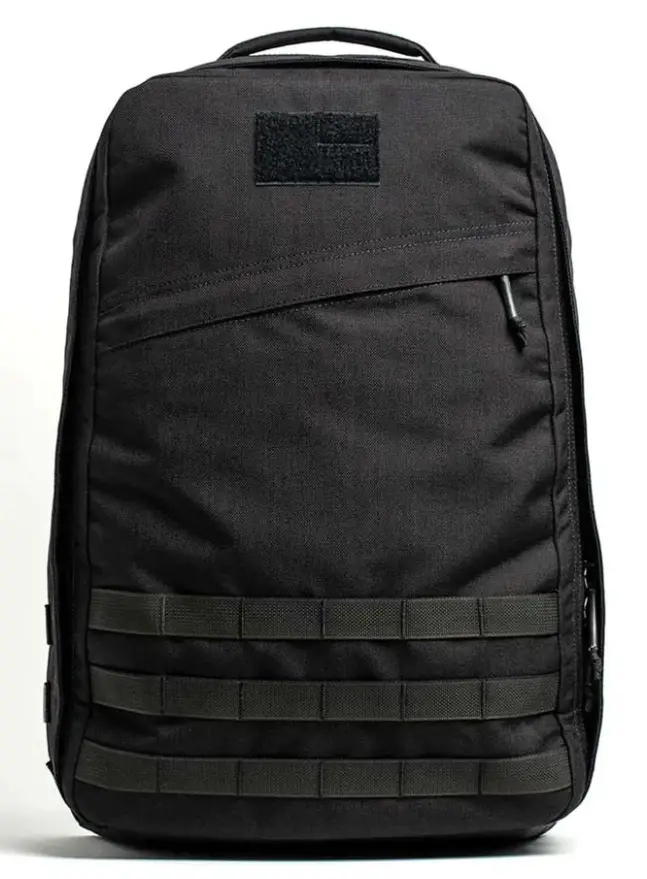I embarked on a transformative journey to sustainable weight loss and improved fitness. Tired of fad programs, I shifted my focus from quick results to prioritizing my health and well-being. Through meticulous tracking of my rucking sessions and calorie intake, I found the right balance that worked for me.
Embracing a mindset of long-term fitness goals, I learned valuable lessons about balance and sustainable lifestyle changes. This rucking body transformation has empowered me to live a healthier, happier life.
In this post, I want to detail my journey and the step I took to transform my body through rucking and some additional workouts (which mainly included CrossFit training).

Table of Contents:
1. Weight Loss Struggle
2. My Experience Rucking To Get In Shape
3. How Rucking Helped Me Transform My Body: Rucking Body Transformation Plan
4. Setbacks Faced Transforming My Body Through Rucking
5. How I felt After Getting in Shape From Rucking
6. How I Maintained My Physique After my Transformation
7. Lessons Learned From My Rucking Body Transformation
Weight Loss Struggle
In the past, I’ve experimented with various 8-week programs in an attempt to get into shape. Some yielded positive results, while others fell short. Yet, a recurring pattern emerged every time I endeavored to shed fat and achieve better fitness. Drastically restricting my calories and pushing myself to exercise excessively proved unsustainable.
Following a typical 8-week program, I found myself regaining the weight I had lost. Initially, I believed that once I reached my desired physique, maintaining it would be a breeze. Reality taught me a different lesson – getting in shape is merely the initial and simpler part of the journey; the true challenge lies in sustaining those hard-earned results.
Throughout the COVID lockdown, I unabashedly indulged in chips and whatever else I craved, with my movement confined within the confines of my tiny 450 square feet apartment, as I worked remotely from home.
On an average day, my daily movement barely exceeded 300 steps.
Avoiding mirrors to dodge the truth became a regular habit, but one day, it caught up with me when I realized I couldn’t run for more than a minute without feeling on the brink of collapse.
The turning point came during a playtime session with my nephews, where I struggled to run for a mere 30 seconds, feeling dreadful and fearing that I’d pass out at any moment. It was then that I was utterly repulsed by the way I had taken my health for granted, disgusted by the lifestyle I had adopted.
Gazing hard at myself, I recognized the need for change. A profound transformation in the way I lived was imperative.
My Experience Rucking To Get In Shape
Once I shifted my mindset to prioritize my overall health rather than obsessing over achieving a quick transformation in just three months, I devised a workout plan that embraced realism and ensured a sustainable approach to my diet.
Here’s a month to month breakdown of what I did to transform my body.
| Month | Activity | Frequency |
|---|---|---|
| 1 | Rucking (10% of Bodyweight) | 3 Rucks a week at 8KM |
| 2 | Rucking (10% of Bodyweight) | 3 Rucks a week at 8KM |
| 3 | Rucking (10% of Bodyweight) & CrossFit | 3 Rucks a week at 9KM 2 CrossFit classes a week |
| 4 | Rucking (15% of Bodyweight) & CrossFit | 3 Rucks a week at 9KM 2 CrossFit classes a week |
| 5 | Rucking (15% of Bodyweight) & CrossFit | 3 Rucks a week at 10KM 2 CrossFit classes a week |
| 6 | Rucking (15% of Bodyweight) & CrossFit | 3 Rucks a week at 11KM 2 CrossFit classes a week |
| 7 | Rucking (20% of Bodyweight) & CrossFit | 3 Rucks a week at 11KM 2 CrossFit classes a week |
| 8+ | Rucking (20% of Bodyweight) & CrossFit | 3 Rucks a week at 12KM 2 CrossFit classes a week |
As we proceed, you’ll notice that by Month 3, I decided to incorporate CrossFit into my regimen. My curiosity led me to explore something new and exciting. Additionally, I noticed some strength-based movements I craved for more but found it challenging to integrate them into my ruck sessions due to fatigue.
Moreover, you’ll notice that I initially started with relatively short rucking distances, and this choice was deliberate. Considering my completely out-of-shape condition, I was cautious not to push myself too hard right from the beginning.
Check out my recent post on how to lose fat and weight from rucking.
How Rucking Helped Me Transformed My Body: Rucking Body Transformation Plan
The essence of my body transformation can be distilled into three key stages: Workout tracking, Calories tracking, and utilizing the right gear.
1.Tracking My Rucking Sessions
Throughout the first 8 months, I set varying distance targets for myself, ranging from 9KM to 12KM. To keep tabs on my rucking sessions, I employed various methods, with Strava being one of my go-to choices. Here’s an example of a past workout I diligently tracked: [insert example here].

In the example above, I was able to track essential details such as the distance covered, time taken, elevation gain, and pace. Analyzing a bunch of records enabled me to gauge improvements in my pace and decide whether it was appropriate or advisable to increase the distance as time went on.

Check out my full list of the best rucking apps to track your workouts.
2. Tracking the Calories I Burned During My Rucking Sessions
Burning calories is a vital component in transforming one’s body. To determine my calorie needs, I started by calculating my Basal Metabolic Rate (BMR), which represents the number of calories my body burned daily without any exercise. Here are my initial stats when I began:
| Stat | |
|---|---|
| Weight | 165 lbs |
| Height | 5 Feet 8 Inches (172 cm) |
| Age | 28 |
| Activity Level | Sedentary: little or no exercise |
| Sex | Male |
After the calculation, my BMR came out to be 1685 calories. To maintain my weight, I needed around 2000 calories daily, as determined by a BMR calculator. However, since my goal was weight loss, I aimed for a calorie deficit, so I maintained a daily calorie intake of 2000 calories while incorporating my workouts. This would put me in a good calorie deficit.
Every month, I recalculated my calorie needs based on any changes in my body and physical activity levels. Additionally, I listened to my body, and if I felt overly hungry or that my calorie targets weren’t sufficient, I added approximately 100 calories to my intake.
How I determined the number of calories I burned on my Rucking Sessions
To determine the number of calories I burned during my rucking sessions, I utilized both a rucking calculator and my smartwatch, taking an average of the results. Although calculators provide estimates, they may not be entirely accurate, which is why I relied on my Samsung Smartwatch, paired with the Samsung Health App, to provide additional insights and cool stats.
Here’s a snapshot of my entry for one of my workouts:

For instance, during one of my rucking workouts, I used my Samsung Watch to track the number of calories burned, alongside other stats like pace. This combination of tools helped me gauge my energy expenditure more effectively.

How I Tracked My Calories During My Body Transformation: Diet Explained

After determining the necessary calorie intake for my weight loss journey, I meticulously designed my diet. During Month 1, it was crucial to keep my daily calorie consumption at 2,000 calories. I strategically planned my meals to stay within this limit.
Given my love for sweets, I made a conscious effort to swap high-calorie chocolates with alternative desserts like chocolate flavored protein bars. This way, I could satisfy my cravings while staying within my calorie budget.
To effectively track my calorie intake, I relied on MyFitnessPal, a convenient app that allowed me to monitor my daily caloric intake and provided a comprehensive breakdown of calories per macronutrient (Carbohydrates, Protein, and Fat). With this tool, I could keep a close eye on my nutrition and maintain a balanced diet throughout my transformation journey.


As time passed, approximately by Month 3 of my transformation, I found myself less dependent on the app for tracking my meals. I had settled into a routine where I consumed essentially the same foods every day (admittedly, it might sound boring, but I’m one of those people who can easily stick to a consistent diet).
3. Rucking Gear Used During My Rucking Transformation
People have diverse preferences when it comes to rucking gear. In my case, I found that three main items were essential: Shoes, Socks, and a proper Rucksack.
1. Rucking Socks
Taking care of my feet during rucks was a top priority, especially since I’m prone to blisters and excessive feet sweat. For quite some time now, I’ve relied on Mudgears ruck socks, and they have proven to be excellent.
I chose these socks for the following reasons:
- The compression fit ensures they stay in place without slipping off.
- There are two padded areas in the toes and heel, providing added comfort.
- They effectively absorb sweat, leaving my feet dry by the end of the ruck.

Check out the Mudgear Rucking Socks here (link to Mudgear)
Use Promo Code ‘RFM15’ for a 15% discount
if you’re looking for more options, check out my full review of the best socks for rucking.
2. Rucking Shoes
In my quest for the perfect rucking shoes, I sought a pair that could serve both my rucking sessions and CrossFit workouts.
I eventually settled on the GORUCK Ballistic Trainers due to their impressive versatility. These shoes proved to be the ideal companion for my CrossFit routines, which involved running, weightlifting (including deadlifts, squats, and other compound movements), and of course, rucking.

I landed on the GORUCK Ballistic Trainers because of how versatile they are. I was able to use them during my CrossFit workouts that involved running, lifting (deadlifts, squats, and other compound movements) and rucking.
They were also very easy to clean, a year later and they’re still in tiptop shape. Here’s a before and after shot of how dirty I got them and how easy it was to clean them up.
Notably, their easy-to-clean feature was an added bonus. Even after a year of use, they remained in impeccable condition. Here’s a before and after shot showcasing how dirty they got during my rucks and how effortlessly I could restore them to their pristine state.


Check out the GORUCK Ballistic Trainers on GORUCK (Link to GORUCK)
Check out my full review of the GORUCK Ballistic Trainers and the best shoes/boots for rucking
3. Rucksack
A reliable rucksack plays a crucial role in any rucking body transformation journey. I knew I needed a pack that would provide maximum comfort and get the job done efficiently. Durability was another key consideration as I wanted to invest in a single rucksack that would stand the test of time.
In my search, I prioritized finding a rucksack with the right size, capable of accommodating the weight of my ruck plates while maintaining comfort. Features like adjustable shoulder straps, and sternum straps.
Moreover, a breathable back and shoulder pads were vital to ensure comfort during intense rucking sessions. I also sought a quality rucksack that fit my budget and offered a warranty to avoid the hassle of rucksack shopping again in the future.
With a ton of available options, my top pick was the GORUCK GR1, which met all my requirements and proved to be an excellent investment for my rucking adventures.
The GR1 rucksack stands out as a favorite for many reasons. Its 210D back panel and shoulder straps offer exceptional comfort without abrasion on fabric or skin.
The pack opens flat for effortless packing and organization, while extra-padded shoulder straps and a top handle ensure comfortable carrying of heavier loads. The bombproof laptop is perfect for storing ruck plates.
Multiple internal pockets, an external slant pocket for quick access, and MOLLE attachments for customization, the GR1 is incredibly versatile.
It’s also rainproof and TSA compliant for easy travel, and with Scars Lifetime Guarantee, it’s built to last and backed by a lifetime warranty.
Check out the GORUCK GR1 Rucksack on GORUCK (Link to GORUCK)
Check out my full review of the best rucksacks for rucking and other GORUCK alternative rucksacks
Setbacks Faced Transforming My Body Through Rucking
As with any mission or journey in life, I did face my ups and downs.
The first struggle I faced was my diet.
My Diet Struggle During my Rucking Body Transformation
In general, I don’t struggle with eating the same foods day in and day out, even though it can get monotonous, I manage to stick to it. However, my diet challenges arose every weekend when I met up with friends and family.
The thought of indulging in junk food over the weekend always stressed me out. After all, who wants to eat rice, chicken breast, and broccoli while out and about with loved ones?
Balancing my social life with my primary goal of transforming my body became quite challenging. Eventually, I had to come to the realization that allowing myself 1 or 2 calorie-dense meals a week wouldn’t set me back significantly as long as the rest of my meals remained healthy.
I adopted a different perspective on this issue. If I ate 3 meals a day for 7 days, that would add up to 21 meals in a week. With 19 of those meals being healthy and only 2 meals being indulgent, overall, I was still doing well in maintaining a healthy diet.
On the other hand, if hypothetically, I had 19 unhealthy meals and only 2 healthy ones during the week, I wouldn’t make any progress with weight loss.
Shifting my mindset allowed me to strike a balance and live a more wholesome and balanced life. I realized that occasional treats during social gatherings were acceptable, as long as I remained committed to making healthier choices in the majority of my meals. This mindset change eased my stress and enhanced my overall well-being throughout the transformation process.
How I felt After Getting in Shape from Rucking
Getting in shape for the first time in my life brought along a ton of benefits.
The rucking sessions helped me greatly with my endurance. The CrossFit sessions helped my -VO₂ max – which is the maximum rate of oxygen consumption attainable during physical exertion.
My rucking sessions helped me with my LISS workout (Low Intensity Interval training) while CrossFit helped me with my HIIT (High – Intensity – Interval – Training) training. For me, the balance helped me achieve the best balance.
The rucking sessions played a pivotal role in improving my endurance, while the CrossFit sessions significantly boosted my VO₂ max (the maximum rate of oxygen consumption attainable during physical exertion).
Combining the rucking sessions for LISS workouts (Low-Intensity Interval Training) and CrossFit for HIIT (High-Intensity Interval Training) allowed me to strike the perfect balance, resulting in remarkable progress.
Experiencing the newfound ability to run was a game-changer for me. I could now energetically keep up with my active nephews, and my confidence soared to its peak. It wasn’t just about the aesthetics or having visible abs for the first time; it was the sense of accomplishment that truly elevated my self-assurance.
I am grateful that I managed to achieve a life goal that once seemed unattainable. The journey was challenging, and the beginning was grueling, but my body adapted and persevering through the mental and physical challenges allowed me to reach new heights in terms of my performance.
This transformation was not only about physical changes; it was a testament to the power of pushing one’s mindset and body to the limit to unlock new levels of achievement.
How I Maintained My Physique After my Transformation Through Rucking & CrossFit
Shifting my mindset to prioritize enjoyment in my workouts, rather than obsessing over calorie counting, has been the key to sustaining my results.
For me, the secret to maintaining my progress lies in setting and achieving short-term goals. Instead of fixating on aesthetics, I direct my focus towards increasing the weights during my ruck sessions and improving my pace.
At this stage, achieving a desirable appearance becomes a natural byproduct of my dedicated efforts. By embracing this approach, I’ve found greater fulfillment and long-term success in my fitness journey.
Lessons Learned From My Rucking Body Transformation
1. Start Slow
From what I’ve learned in the past and from my own experience, the biggest reason why most people fail (and why I failed in the past) is because they get overly enthusiastic in the beginning, hoping for rapid results. However, this eagerness leads them to overwork themselves, making sudden lifestyle changes that are ultimately unsustainable, causing them to quit after just a few days.
To ensure my success, I followed a workout schedule that started with shorter rucking distances and less intense workouts, gradually progressing as I built up my stamina. This approach played a pivotal role in achieving sustainable results.
2. Investing in a Good Rucking Gear is Totally Worth It
Since I was fully committed to a rucking workout program, I recognized the value of investing in high-quality gear.
Having a comfortable rucksack is essential when lifting heavy weights; you don’t want to deal with rashes or sore shoulders caused by inadequate shoulder straps from a regular school backpack.
The same principle applies to rucking shoes – by opting for my reliable GORUCK Ballistic Trainers, I managed to avoid blisters and ensure the longevity of my footwear.
In summary, upgrading my gear was undoubtedly worth it, considering the long-term commitment I made to my workout program. The right gear significantly contributed to my comfort and overall success in my rucking transformation.
Final Thoughts
I wholeheartedly believe that the combination of Rucking and CrossFit served as the ideal recipe for me to achieve the desired level of fitness. However, it’s crucial to recognize that this approach may not suit everyone.
Through this experience, I’ve come to understand the significant impact of shifting my mindset from solely aiming for weight loss to prioritizing overall health and well-being.
I’ve learned that focusing on transforming my body for a specific event or occasion is not sustainable in the long run. Often, drastic calorie reduction pushes the body into a constant state of starvation, leading to unhealthy behaviors like binge eating towards the end of the transformation period.
Instead, embracing the mindset of getting in shape to lead a healthier life has proven to be the game-changer for me. This shift in perspective fosters a sustainable approach, promoting well-being beyond just aesthetic goals. It’s essential to find an approach that aligns with individual preferences and long-term health aspirations.
The key lies in creating a balance between fitness routines and nutritional choices that are both enjoyable and conducive to maintaining a healthy lifestyle.
Frequently Asked Questions
Can You Get In Shape From Rucking?
Yes, rucking alone is capable of getting you in great shape. The secret is to stay consistent, track your pace, and gradually increase the weight in your rucksack to see optimal results.
It is imperative to pair your rucking workouts with a clean diet and maintain a caloric intake or stay at a caloric deficit (if you’re trying to lose fat) for a certain time period. This is subjective depending on your goals.
From my experience, I found that rucking alone got me stronger. I gained strength in my lower body and noticed that my lifts in the gym (back squats, front squats, and deadlifts) started to improve and was noticing that I was able to life more weights gradually.
What Muscles does Rucking Develop?
Rucking develops the following muscles:
- Quadriceps (especially if rucking on an incline)
- Hamstrings
- Calves (especially if rucking on an incline)
- Abdominals (works as a stabilizer when rucking with the right form)
- Back
Can you get ripped by rucking?
Yes, rucking can help reveal muscles by aiding in fat loss for those with existing muscle mass.
The key here is that one must have a decent amount of muscle mass because when you lost the fat, whatever was hiding behind it will show. So if you’re able to maintain your muscle mass (through proper dieting) and lose fat, you can get ripped by rucking.

